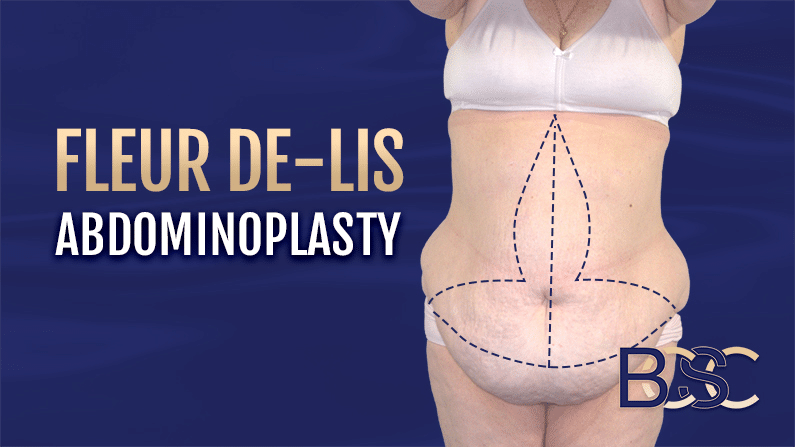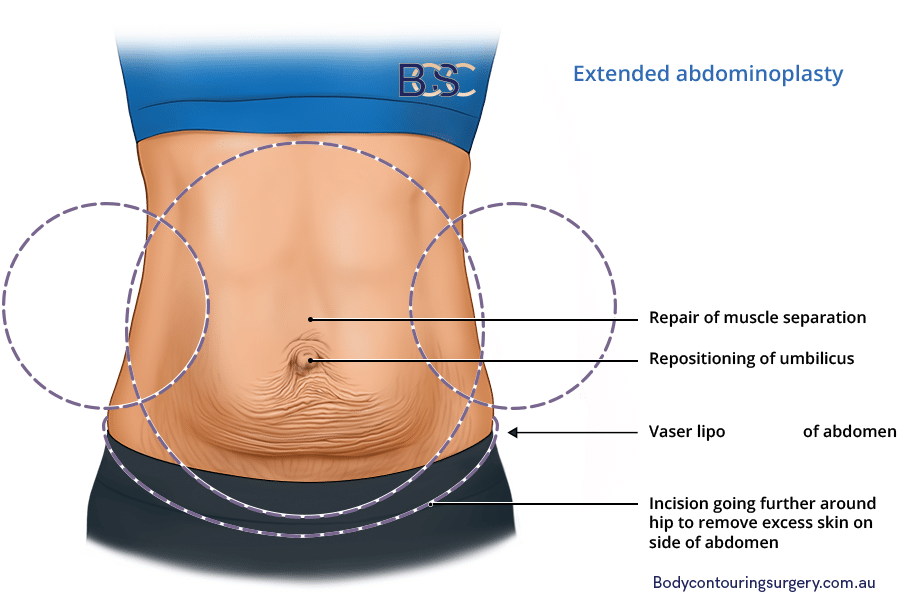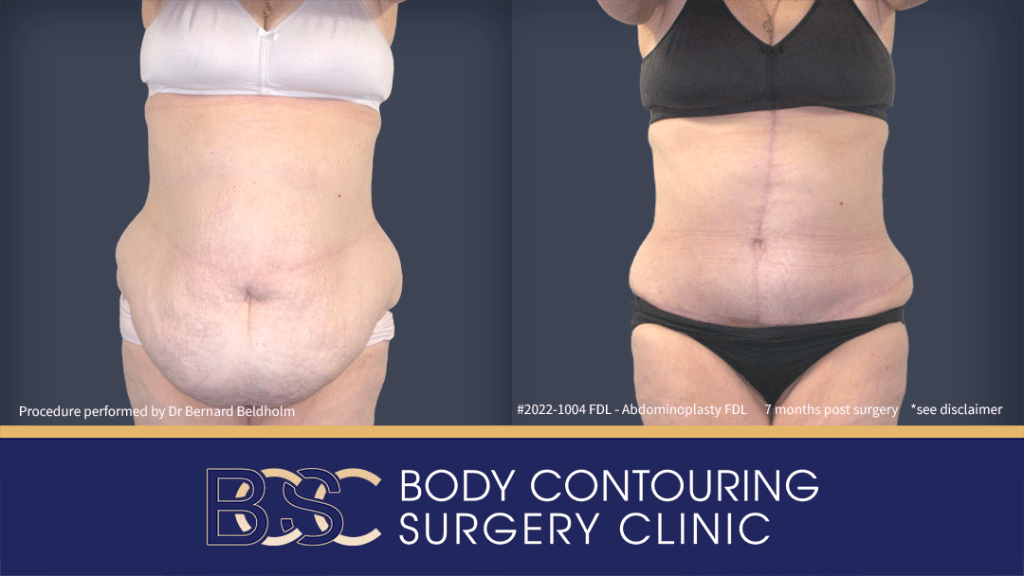Fleur-de-Lis Abdominoplasty After C-Section Surgery
Fleur-de-Lis abdominoplasty helps ** excess abdominal skin and separated abdominal muscles resulting from caesarean section (c-section) delivery. While some women would prefer to undergo FDL abdominoplasty surgery on the same day as their c-section delivery, Dr. Beldholm recommends waiting at least 12 months.
Childbirth greatly impacts a woman’s body, altering her looks dramatically in the short run, and significantly in the long run. C-section delivery, in particular, can lead to severe changes such as redundant abdominal skin and fat and abdominal muscle weakness. Many of those women who find themselves dissatisfied with these changes consider undergoing body contour surgery such as abdominoplasty to ** their pre-pregnancy looks. When it comes to abdominoplasty (tummy tuck), there are several options available: full and extended abdominoplasty, mini abdominoplasty, and fleur-de-lis abdominoplasty.

Post-pregnancy fleur-de-lis abdominoplasty ** the loose and excess abdominal skin after a C-section and repairs separated abdominal muscles, enhancing the abdominal contour.
However, as effective as fleur-de-lis abdominoplasty can be, there are several reasons why it’s better to wait to have this procedure rather than having the two surgeries performed simultaneously.
This guide will ** common concerns, reviews the benefits, and reveals the possible complications of undergoing fleur-de-lis abdominoplasty either at the same time or after c-section surgery.
Why Wait to Undergo Fleur-de-Lis Abdominoplasty After a C-Section
Most medical practitioners recommend waiting for about 12 months after undergoing a C-section before considering a fleur-de-lis abdominoplasty.
A c-section delivery leads to an abdominal wound and trauma to the abdominal muscles; hence, the patient should wait to recover before undergoing another surgical procedure. This reduces the recovery period that would result from combining the two procedures. It also ensures the body adapts to the hormonal changes and postpartum transitions.

Waiting also offers the patient time to plan for the Fleur-de-Lis abdominoplasty. Fleur-de-Lis abdominoplasty is a major surgery requiring both physical and mental preparation. During the waiting period, the patient loses most of the post-pregnancy weight and attains a stable weight for an abdominoplasty. Attaining a stable weight before Fleur de Lis procedure reduces the risk of post-surgical complications due to weight fluctuations, minimising the risk of revision surgery.
Undergoing a Fleur-de-Lis abdominoplasty will restrict the interactions between the mother and the child. This is to avoid trauma to the Fleur-de-Lis incision, which extends to the lower and upper abdomen. Also, the mother may be under the influence of pain medication after Fleur-de-Lis abdominoplasty, which may affect breastfeeding.
Waiting for Fleur-de-Lis surgery allows the mother and child to bond after birth.
Caesarean Section vs. Fleur-de-Lis Abdominoplasty
A caesarean section, often referred to as a C-section, is a surgical child delivery procedure. It has evolved over the years, becoming among the most common and ** childbirth procedures.
A C-section involves an abdominal incision and another in the uterus. The incision is located horizontally along the lower abdomen. After cutting through the different skin layers, the surgeon makes an incision in the uterus. The next step involves removing the baby from the uterus, cutting the umbilical co to separate the baby from the mother, and suturing the incision.
Due to the surgical risks of a C-section, the procedure is recommended for women who cannot have virginal delivery due to complications or women who had a C-section for their previous delivery. A study on caesarean section notes that “[w]hile it confers risks of both immediate and long-term complications, for some women, caesarean delivery can be the ** or even the only way to deliver a healthy newborn.”
Fleur-de-Lis tummy tuck is a surgical procedure that ** excess abdominal fat and skin, repairs separated abdominal muscles (diastasis recti), and repositions the umbilicus (belly button) when required. The excess abdominal fat and skin and separated abdominal muscles may result from pregnancy, childbirth, massive weight loss, genetic predisposition, and age, among other factors.
Fleur-de-Lis abdominoplasty ** the abdominal contour, strengthens the abdominal muscles, and ** other complications, including incontinence, hernias, and previous abdominal scars. The standard abdominoplasty incision is located horizontally at the lower abdomen, similar location to a C-section incision.
However, the incision may be extensive depending on the surgical area. For example, a Fleur-de-Lis incision involves a horizontal incision at the lower abdomen and an additional vertical incision running along the midline, creating an inverted T incision. The incision ensures the surgeon ** loose skin horizontally and vertically.
Body Contouring Surgical Options Available After a C-Section
Several abdominoplasty procedures are available for patients who want to get rid of excess abdominal fat and skin after a C-section. The suitability of each procedure depends on individual goals and the amount of excess skin and fat being removed. Therefore, patients should consult a specialist surgeon to determine the suitable abdominoplasty procedure.
Let’s look at the primary abdominoplasty procedures available after a C-Section.
Mini Abdominoplasty

A mini abdominoplasty is the least invasive abdominoplasty procedure. It ** minimal loose skin only on the lower abdomen and doesn’t involve repairing separated abdominal muscles or repositioning the belly button.
A mini abdominoplasty incision is smaller than a full abdominoplasty. The incision runs horizontally along the waistline and is easily ** with underwear. The procedure suits patients with minimal loose skin only on the lower abdomen and no abdominal muscle separation.
Complete/ Full Abdominoplasty and Extended Abdominoplasty

A full abdominoplasty ** redundant loose skin and excess fat on the lower and upper abdomen and corrects diastasis recti (separated abdominal muscles). The procedure also repositions the belly button if required.
It involves a horizontal hip-to-hip incision on the lower abdomen along the waistline. Repositioning of the belly button involves an additional incision around it. Patients with significant loose skin on the entire abdomen are the most suitable for this procedure.

Extended abdominoplasty ** loose skin and excess fat on the entire abdomen, hips, and back, making it more invasive than a full abdominoplasty. Therefore, it results in a more extensive incision. An extended abdominoplasty incision runs horizontally from hip-to-hip and may also involve an additional vertical incision when ** massive loose skin.
The procedure suits women with significant loose skin on the entire abdomen, back, and hips, which is common in women who have had multiple pregnancies.
Fleur-de-Lis Abdominoplasty
A c-section delivery may cause additional weakness in the abdominal muscles, cause skin redundancy, and fat accumulation in the lower abdomen. This is in addition to the pregnancy effects that include weakened abdominal muscles and loose skin on the abdomen due to weight changes. An abdominoplasty procedure will help ** this problem.
Waiting until patients are fully recovered from the C-section and discussing the procedure with their specialist surgeon will ensure that the surgeon can properly assess the patient’s needs and determine the suitability of the procedure, as well as possible risks.
Please note that the choice of abdominoplasty depends on the extent of loose skin and muscle separation.

Disclaimer: Operation performed by Dr Bernard Beldholm. Adult content, surgery has risks; individual results vary, seek 2nd opinion. Please see the full disclaimer.
Fleur-de-lis abdominoplasty is a surgical procedure that can be considered after a C-section, though on rare occasions, to ** excess skin and tissue in the abdomen. It involves making a horizontal and vertical incision to remove excess tissue both horizontally and vertically, resulting in a more contoured abdominal appearance. This technique is particularly beneficial for individuals with significant laxity in both dimensions of the abdomen. The end result is a more contoured abdominal appearance, ** concerns such as loose skin folds and protrusion.
It’s important to note that this procedure involves a more extensive incision than traditional tummy tuck (abdominoplasty) resulting in a longer recovery period and more noticeable scarring.
In case of post-pregnancy changes, FDL is not a common choice of operation after pregnancy. However, if there is a significant amount of loose skin then it may be considered but will involve significant scars.

Fleur de lis (french water lilly)
- Removing redundant and loose abdominal fat and skin
- Correcting diastasis recti (separated abdominal muscles)
- Enhancing the abdominal contour
- Tightening loose abdominal muscles
- Enhancing/ correcting the C-section scar appearance
- Treating urinary incontinence (a urinary complication due to weak pelvic floor muscles, common in women after birth)
- ** post-pregnancy abdominal stretch marks
- Enhancing the umbilicus (belly button) appearance
- ** posture and minimising discomfort and back pain
Combining a C-Section and Fleur-de-Lis Abdominoplasty
Some women may consider undergoing a C-tuck, which combines abdominoplasty and a C-Section to avoid surgery in the future.
A C-tuck procedure involves child delivery and abdominal contouring. The surgeon delivers the baby and then ** the loose abdominal skin and weakened abdominal muscles.
However, the question is whether combining a C-Section and abdominoplasty is possible. The answer is yes. Women can undergo a C-tuck, however, Dr. Bernard Beldholm strongly discourages combining the two procedures because they may result in complications that can be avoided or reduced if performed separately. This is because each procedure is considered a major surgery.
There are several reasons Dr. Beldholm is not in favour of a C-Tuck surgery, including:
- Higher risk of complications
- Increased recovery period
- Increased possibility of unsatisfactory results.
- Poses a high risk to the patient
- It is challenging to find two doctors who can perform two separate procedures at once as the surgeon performing the C-Section differs from the one conducting the abdominoplasty.
Complications Resulting from Combining C-Section and Fleur-de-Lis Abdominoplasty
Combining a C-section and an abdominoplasty increases the risk of complications after the procedure. These complications include:
- Wound infection: Every surgical procedure leaves an incision wound. Combining the two procedures results in a bigger incision, which is prone to bacterial contamination if care is not taken.
- Wound dehiscence: This is the partial or full reopening of the incision. The risk of wound dehiscence increases due to the procedure’s invasiveness and large surgical area.
- Skin necrosis: The death of the skin cells around the incision wound due to inadequate blood reaching the site.
- Seroma: The accumulation of the lymphatic fluid around the incision site
- Haematoma: The accumulation of blood, commonly clotted blood, around the incision site
- Thrombosis: The formation of blood clots in the blood vessels
- Bad scarring: The patient may develop bad scarring, thick, hypertrophic, or scars extending past the incision site due to the procedure’s extensiveness
- Outward bulging umbilicus: Also known as umbilical hernia occurs when the abdominal muscles allow abdominal tissue or organs to protrude through the weakened area around the belly button.
- Outward bulging abdomen: Occurs due to the added strain on weakened abdominal muscle from both surgeries, potentially leading to poor wound healing, seroma formation, and unsatisfactory results.
- Skin redundancy: Arise due to removal of excess skin during abdominoplasty creating tension and inadequate closure of the incision which may necessitate further corrective procedures.
An evaluation of combining a C-section and an abdominoplasty of 50 women resulted in “[n]ine patients (18%) developed wound infection; three of them (9%) developed wound dehiscence. Six patients (12%) developed lower abdominal skin necrosis; three of them (6%) were treated conservatively and healed by secondary intention, while surgical debridement and secondary sutures were needed in the other three patients (6%). Residual abdominal skin redundancy in 9 patients (18%), outward bulging of the abdomen and lack of waist definition in 16 patients (32%), and outward bulging of the umbilicus in 12 patients (24%).”
The study concluded that “[a]bdominoplasty combined with Cesarean delivery carries a higher incidence of complications and does not give the desired aesthetic outcome.”
Another study on abdominoplasty with Caesarean section or natural delivery notes that “[t]he combination of abdominoplasty with [Caesarean] section or natural delivery has a high incidence of complications and poor aesthetic results.”
Suggested Waiting Period after C Section
Dr. Beldholm suggests that patients should wait until they have recovered from the C-section before undergoing an abdominoplasty. The recovery period varies in each patient, with an approximate period of 6-12 months.
Most surgeons recommend waiting for at least 12 months after a C-section before undergoing an abdominoplasty to ensure full recovery. An extensive study published by the National Library of Medicine warns against combining C-section surgery with abdominoplasty “[t]herefore, we make a strong recommendation to avoid this practice before the patient reaches sixth month postpartum.”
Cost of FDL Surgery
The cost of Fleur-de-Lis surgery will vary for each patient, depending on individual goals, the amount of skin being removed, and whether liposuction is involved. In addition, the cost may vary depending on the clinic’s location, the anaesthesia fees, the surgeon’s experience, and hospital fees.
Therefore, patients considering a Fleur-de-Lis tummy tuck procedure should consult a specialist surgeon for their customised quotation. The patient should ensure they understand what is included in the price quotation and any other additional expenses that aren’t included.
Bottom Line
Pregnancy results in significant weight changes, causing loose skin in the abdomen and weakening abdominal muscle. Delivery through a C-section adds to the redundant abdominal skin and the weakening of the abdominal muscles.
A Fleur-de-Lis abdominoplasty helps ** the loose redundant abdominal skin and repairs the separated abdominal muscles. However, most surgeons recommend waiting around 12 months after a C-section before considering an abdominoplasty. This ensures full recovery from the C-section and reduces the risk of combining the two procedures.
References
- Benn, T. E., & Spera, C. E. (2014). Abdominoplasty Combined with Caesarean Section: Discussion of the Evidence. The American Journal of Cosmetic Surgery.
- Berghella, V., Baxter, J. K., & Chauhan, S. P. (2005). Evidence-based surgery for caesarean delivery. American Journal of Obstetrics and Gynecology, 193(5), 1607–1617.
- Iribarren-Moreno, R., Cuenca-Pardo, J., & Ramos-Gallardo, G. (2019). Is Plastic Surgery Combined with Obstetrical Procedures Safe? Aesthetic Plastic Surgery, 43(5), 1396–1399.
- Ali, A., & Essam, A. (2010). Abdominoplasty Combined with Caesarean Delivery: Evaluation of the Practice. Aesthetic Plastic Surgery, 35(1), 80–86.
- Bhargava, D. (2008). Abdominoplasty today. Indian Journal of Plastic Surgery : Official Publication of the Association of Plastic Surgeons of India, 41(Suppl), S20.
- Cormenzana, P. (2010). Revision abdominoplasty and proper umbilical positioning. Clinics in Plastic Surgery, 37(3), 541–546.
- Sandall, J., Tribe, R. M., Avery, L., Mola, G., Visser, G. H., Homer, C., Gibbons, D., Kelly, N., Kennedy, H. P., Kidanto, H., Taylor, P. D., & Temmerman, M. (2018). Short-term and long-term effects of caesarean section on the health of women and children. The Lancet, 392(10155), 1349–1357.
- Ali, A., Essam, A. Abdominoplasty Combined with Caesarean Delivery: Evaluation of the Practice. Aesth Plast Surg 35, 80–86 (2011).
- Coldron Y, Stokes MJ, Newham DJ, Cook K (2008) Postpartum characteristics of rectus abdominis on ultrasound imaging. Man Therapy 13(2):112–121
- Iribarren-Moreno, R., Cuenca-Pardo, J., & Ramos-Gallardo, G. (2019b). Is Plastic Surgery Combined with Obstetrical Procedures Safe? Aesthetic Plastic Surgery, 43(5), 1396–1399.
- Karunaratne, Y. G., Romeo, P. B., Willis, M., & Sanki, A. (2023). The Safety and Effects of Pregnancy after Abdominoplasty: A Systematic Review of the Literature. Aesthetic Plastic Surgery, 47(4), 1472–1479.
- Friedman, T., O’Brien Coon, D., Michaels V, J., Purnell, C., Hur, S., Harris, D. N., & Rubin, J. P. (2010). Fleur-de-Lis abdominoplasty: a safe alternative to traditional abdominoplasty for the massive weight loss patient. Plastic and reconstructive surgery, 125(5), 1525–1535.
- Duff, C. G., Aslam, S., & Griffiths, R. W. (2003). Fleur-de-Lys abdominoplasty–a consecutive case series. British journal of plastic surgery, 56(6), 557–566.
- Mitchell, R. T., & Rubin, J. P. (2014). The Fleur-De-Lis abdominoplasty. Clinics in plastic surgery, 41(4), 673–680.



